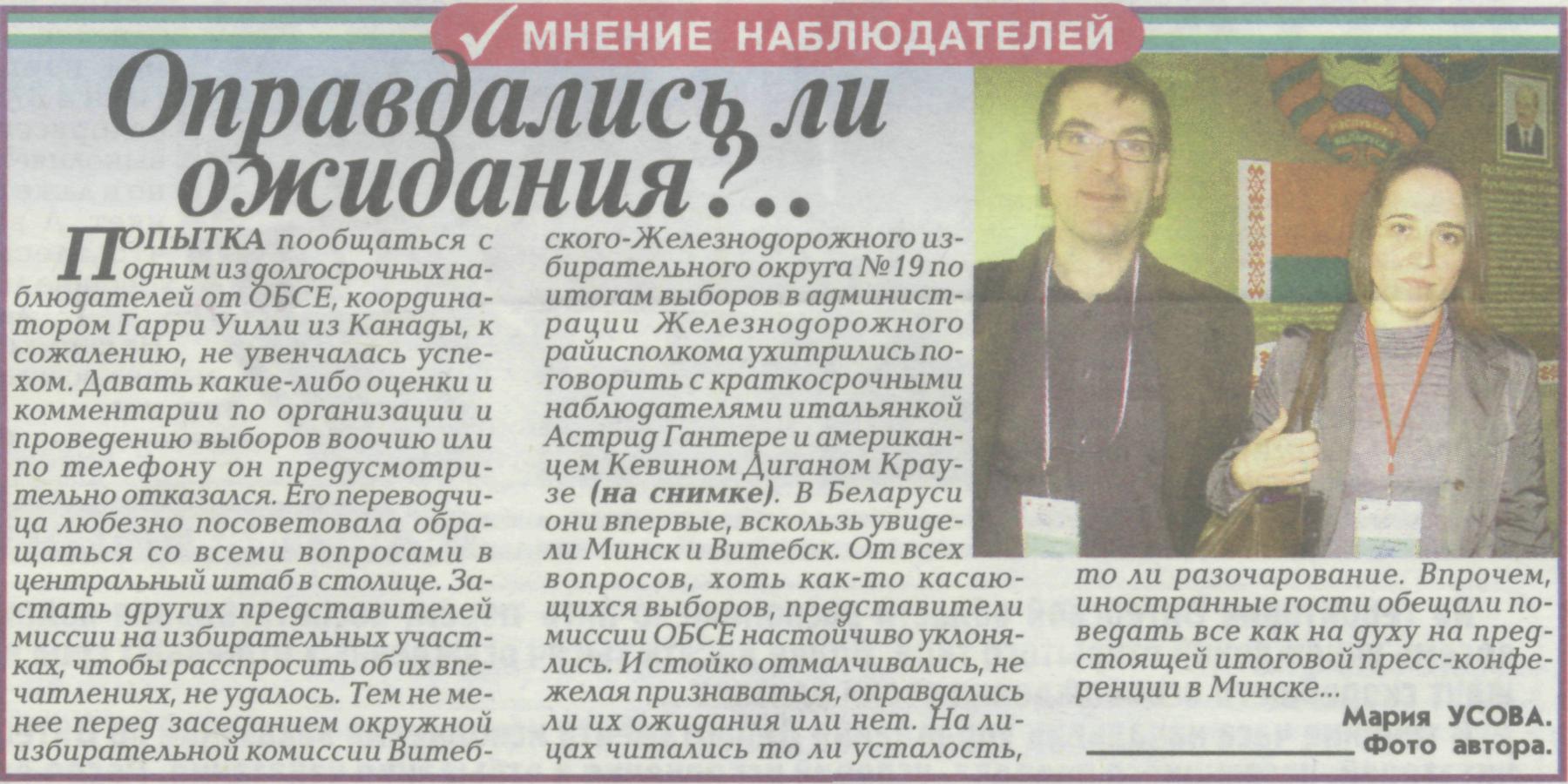I returned two days ago from Belarus where I was an observer in the 2008 parliamentary elections.

OSCE rules request that we leave assessments to the organization’s main report and remain silent. Fortunately, in this instance, the OSCE judgement so closely corresponds to my own experience that I can refrain from my own judgments and express my own empressions exclusively through quotations from the initial report. That report can be found online at http://www.osce.org/item/33272.html. Unless otherwise noted, the quotations reflect my own personal experience.
The Scope Of The Mission:
As OSCE notes, “On Election Day, 449 observers were deployed to observe the opening of polling stations, the process of voting, the vote count, and the tabulation of the votes at DECs. This included 76 specially designated teams to observe the tabulation process.”
What Went Relatively Well: The Voting Process
The OSCE report perfectly mirrors my own experience regarding the experience of voters in the voting process:
- “On election day, observers reported that voting was well conducted overall in those polling stations visited.”
- “Observers generally evaluated the opening procedures as good or very good in 100 per cent of the 93 cases observed.”
- “The voting procedures were also positively assessed by observers, with 95.4 per cent of cases evaluated as good or very good.”
With a relatively minor exception:
- “Campaign materials were displayed inside polling stations in 3 per cent of cases.”
What Did Not Go Quite As Badly: The District Election Commission Process
Again, the OSCE report mirrors my own experience regarding the conduct of the aggregation of the count at the district level:
- “While some opposition candidates claimed to have been the subject of pressure on the part of local administrations, other candidates, including from the opposition, declared that the attitude of DECs was friendlier and more open than in the past and that the pre-election climate was improved.”
Nevertheless, as the OSCE reports,
- “In 54 per cent of tabulations observed, they were not able to observe the figures being entered into the spreadsheet tables.”
What Went Badly: The Counting Process
As the OSCE report concludes, “Voting was generally well conducted, but the process deteriorated considerably during the vote count. Promises to ensure transparency of the vote count were not implemented….” The process deteriorated considerably during the count and tabulation, violating paragraph 7.4 of the Copenhagen commitments of the OSCE.
- “The integrity of the process was undermined by the vote count which was assessed by observers as bad or very bad in 48 per cent of observations [including me]. “
- “37 per cent of observers, including some of those who noted hindrances [i.e. including me], reported not having a full view of the vote count proceeding, thus compromising the transparency of this fundamental element of the election process.”
- “OSCE monitors were prevented or hindered from observing the vote count in 35 per cent of cases. This compromised the transparency of this fundamental element of the election process.”
- “In 50 per cent of cases, early votes were not compared with the number of entries in the voter lists.”
- “Observers could not see the voters’ mark in 53 per cent of cases.
- “Numerous cases were noted of counting procedures taking place in complete silence with small slips of paper being passed between commission members; this significantly undermined any transparency in the count.”
Reading Between the Lines:
What to make of an election that combines relatively smooth voting and district-level counting with comprised transparency at the polling-station counting stage? The OSCE report makes certain suggestions about the possible reasons. These conform to my own experience.
- “From observers comments, in some instances it was noted that there were significant discrepancies between turnout observed and the number of votes noted in PEC protocols…. A high incidence of mobile voting was noted in some cases.”
- “Where access was possible, several cases of deliberate falsification of results were observed…. Deliberate falsification was observed in 5 cases by observers.
If, indeed, the non-transparent counting procedures reflect discrepancies, this requires an explanation of how the aforementioned discrepancies could be combined with a relatively transparent voting process. The OSCE report offers several potential explanations that correspond to my own experience:
- “Lack of clear detailed regulations on the printing of ballots, the number of ballots to be printed, the percentage of extra ballots, and security features”
- “Lacking instructions on observation, each PEC was free to decide on how observation would be dealt with.”
- “The Electoral Code does not provide any clear mechanism for securely keeping the ballot boxes after the start of early voting, nor does it provide specific regulations for enhancing the integrity of the ballot.”
- “The lack of any official protocols to document the record of voting on each day of early voting remains a concern. These outstanding issues allow the possibility of electoral malfeasance.”
And, perhaps most significant of all,
- In nearly all cases in which OSCE/ODIHR EOM observers had access to such information, they reported that PECs were composed of staff from the same place of work, such as enterprises or schools. Existing hierarchical relationships seem to have been transferred to the PEC, i.e. heads or deputy heads of such work places became PEC chairpersons, with their staff as the PEC members. This further contributed to the lack of independence of individuals in the commissions…. The composition of election commissions diminished stakeholders’ confidence in the process.
Most interesting of all, is the question of why. If, as OSCE notes, “The election took place in a strictly controlled environment with a barely visible campaign,” why should engineered discrepancies and falsifications be necessary at all? The need to make minimum turnout requirements? The desire for overwhelming margins of victory? Simple habit? I will leave answers to these questions for other experts and other venues.


